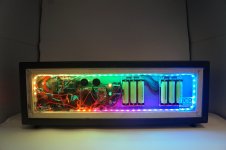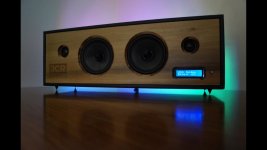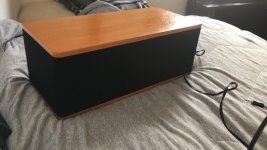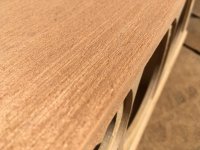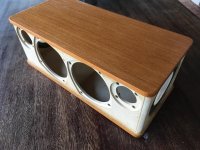Has anyone had any experience using Tang Band W6-1139SIF 6.5" sub-woofers in a sealed enclosure? I was intending on using two in a all in one system along with two Tang Band W5-1685 mid-range drivers and two Seas 27TDFC H1189-06 Tweeters.
I landed on a sealed unit as I am hoping to keep the unit "boombox" style - similar but larger than my previous design (see images) but with the two subs down-firing. I believe this will give me more clarity. The zones for the sub-woofers and other drivers will also be separated (volumes currently undecided). The drivers will be powered by a Bluetooth amplifier I've been developing with an active crossover to separate lows and highs (crossover frequency currently undecided) to two TPA3116D2 Amps. The highs will then pass through a passive crossover to separate the tweeter and mid-range driver for each L/R channel.
Any thoughts on any part of the build would be appreciated but specifically on the sealed sub-woofer section of the unit and any crossover frequency suggestions from those with experience with these drivers. I've spent most my time developing the amplifier thus far so wanted any pointers on the design before I delved too deep down a particular path.
Thanks!
P.S. please ignore my ghetto electronics on the old unit - I've changed I promise!!
I landed on a sealed unit as I am hoping to keep the unit "boombox" style - similar but larger than my previous design (see images) but with the two subs down-firing. I believe this will give me more clarity. The zones for the sub-woofers and other drivers will also be separated (volumes currently undecided). The drivers will be powered by a Bluetooth amplifier I've been developing with an active crossover to separate lows and highs (crossover frequency currently undecided) to two TPA3116D2 Amps. The highs will then pass through a passive crossover to separate the tweeter and mid-range driver for each L/R channel.
Any thoughts on any part of the build would be appreciated but specifically on the sealed sub-woofer section of the unit and any crossover frequency suggestions from those with experience with these drivers. I've spent most my time developing the amplifier thus far so wanted any pointers on the design before I delved too deep down a particular path.
Thanks!
P.S. please ignore my ghetto electronics on the old unit - I've changed I promise!!

Attachments
In addition, as some back of packet calculations. Making the sub-woofer section of the boombox 600 x 250 x 120 (mm) would give me a volume of 18 litres, compliance ratio of 1.308, Fsc of 53.18Hz, Qtc of 0.6078 which I imagine would be in the right ball park for most audio tracks?
Not looking for easy but the best audio quality I can pack into a package of this size.
have you looked into passive radiators?
I'm building a similar boombox, but I ditched the subwoofer after a lot of back and forth, it was simply not worth, I would get only 2 dB more at 40 Hz over using two 4.5" midbass
The key for it is using passive radiators with a low tuning, in my case 40 Hz, and then using eq to flatten the response. The low tunning acts to limit the excursion of the mid bass and allow a significant amount of eq to be applied
Unfortunately a lot of the pictures are down in my build thread and I didn't have time to fix it yet
But the video gives a good idea of the performance
Portable Bluetooth Speaker Build With Passive Radiators Build
YouTube
The key for it is using passive radiators with a low tuning, in my case 40 Hz, and then using eq to flatten the response. The low tunning acts to limit the excursion of the mid bass and allow a significant amount of eq to be applied
Unfortunately a lot of the pictures are down in my build thread and I didn't have time to fix it yet
But the video gives a good idea of the performance
Portable Bluetooth Speaker Build With Passive Radiators Build
YouTube
Thanks Pedro,
Just took a look at the video, the rig looks impressive. Where have you got this project to now? Would be good to see some more recent images. I was inspired slightly by the devialet phantom on this build hence wanting to use two sub-woofers in a sealed enclosure in my design. Whilst people aren't huge fans of them on this site the bass is incredible for their size and on top of that they don't vibrate whatever surface they sit on.
Just took a look at the video, the rig looks impressive. Where have you got this project to now? Would be good to see some more recent images. I was inspired slightly by the devialet phantom on this build hence wanting to use two sub-woofers in a sealed enclosure in my design. Whilst people aren't huge fans of them on this site the bass is incredible for their size and on top of that they don't vibrate whatever surface they sit on.
I actually made two speakers, almost identical, only one is done, the second is almost, the difference is that one of them have no battery, passive crossovers and no DSP, this was for my father
The one is progress is my own, battery powered, fully active (independent amplifiers for mid and tweeters to avoid some crosstalk problem I was having) and powered by a ADAU1701 DSP
The Devialet can surely pump significant bass, but it requires a lot of power, not doable for a battery based system, even in my own I need 12 dB is boost @40 Hz, but in my testing the battery life is still reasonable at 20+ hours at moderate volume and around 5 to 8 hours at full power
But all this comes with a maximum volume penalty, if I tuned my passive radiator to 80 Hz, I wouldn’t need any DSP and the loudness would be increased by 10 dB with the same power. The nice thing about using the DSP is that I can use a limited to tame the excursion and still get the full volume, with reduced bass of course, I need to play with it first
The one is progress is my own, battery powered, fully active (independent amplifiers for mid and tweeters to avoid some crosstalk problem I was having) and powered by a ADAU1701 DSP
The Devialet can surely pump significant bass, but it requires a lot of power, not doable for a battery based system, even in my own I need 12 dB is boost @40 Hz, but in my testing the battery life is still reasonable at 20+ hours at moderate volume and around 5 to 8 hours at full power
But all this comes with a maximum volume penalty, if I tuned my passive radiator to 80 Hz, I wouldn’t need any DSP and the loudness would be increased by 10 dB with the same power. The nice thing about using the DSP is that I can use a limited to tame the excursion and still get the full volume, with reduced bass of course, I need to play with it first
Attachments
Four speakers are responsible for the sound: two at 100 mm and two high-frequency at 20 mm. I am very glad that I could not catch the overload with any track, although at maximum boombox sounds be healthy. The speaker booms great, the chandeliers are really shaking in the room, but the sound is not dull, as in such solutions it is cheaper or from bits.
Nice, looks really good as well!
I've still got a lot to learn on the enclosure side of things with regards to tuning. Do you use WinISD for your designs? Also what did you wrap the box in? I was thinking of doing a white enclosure with a grey felt over the front on mine.
I've used Hornresp, way superior than WinISD for more advanced designs, take all possible speakers and simulate them, looking for excursion, how low can you go and etc. And also don't ignore the high frequency response or it will be a pain to make a crossover kater
This a composite veneer from a local store, I don't remember the name but I know its a Brazilian wood
Attachments
- Status
- This old topic is closed. If you want to reopen this topic, contact a moderator using the "Report Post" button.
- Home
- Loudspeakers
- Subwoofers
- Sealed Boombox Design
